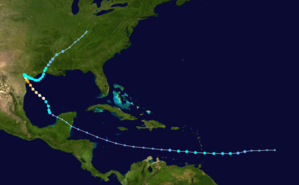User:MarioProtIV/Shortened Harvey
Meteorological history
[edit]
Early on August 13, the National Hurricane Center (NHC) began monitoring a tropical wave on the western coast of Africa.[1] Eventually, it organized enough to be classified as a potential tropical cyclone, allowing tropical storm watches and warnings to be hoisted for portions of the Lesser Antilles.[2] Later that day, it strengthened into Tropical Storm Harvey.[3]
Harvey did not strengthen much in the eastern Carribbean Sea due to moderate wind shear, remaining poorly organized with its low-level center on the eastern edge of associated deep convection.[4] Harvey's presentation began to deteriorate early on August 19; its convective pattern became elongated while the circulation became less defined. In fact, a reconnaissance aircraft was unable to find a loosely-closed circulation at 850 mb (4,781 ft), though it did locate one at lower levels.[5] Harvey was downgraded to a tropical depression at 21:00 UTC on August 19;[6] It was then declared an open tropical wave early on August 20.[7]

Early on August 20, the NHC began monitoring the remnants of Harvey for redevelopment, particularly in the northwestern Caribbean Sea, and especially in the Bay of Campeche.[8] While traversing the Yucatan Peninsula on August 22, satellite images and surface observations indicated that Harvey's circulation became better defined.[9]
Late on August 23, the remnants of Harvey regenerated into a tropical cyclone.[10] attaining tropical storm intensity by 06:00 UTC on August 24.[11] The system slowly consolidated until the early morning of the next day, at which point Harvey began to undergo rapid intensification as an eye developed and its central pressure quickly fell.[12] After becoming a hurricane on August 24, Harvey continued to quickly strengthen over the next day, ultimately reaching peak intensity as a Category 4 hurricane. Around 03:00 UTC on August 26, the hurricane made landfall at peak intensity at Rockport with winds of 130 mph (215 km/h) and an atmospheric pressure of 938 mbar (27.7 inHg).[13] Harvey became the first major hurricane to make landfall in the United States since Wilma in 2005.
After striking land, Harvey rapidly weakened as its speed slowed dramatically to a crawl, and Harvey weakened to a tropical storm a on August 26.[14] For about two days the storm stalled just inland, dropping very heavy rainfall and causing widespread flash flooding. Harvey's center drifted back towards the southeast, ultimately re-emerging into the Gulf of Mexico on August 28.[15] Once offshore, Harvey managed to attain a secondary peak of 50 mph (85 km/h),[16] before making its third and final landfall just west of Cameron, Louisiana, with winds of 45 mph (75 km/h).[17] Associated convection with Harvey became focused north of the center and along a warm front on September 1 as it moved further inland, indicating that the system transitioned into a post-tropical cyclone by 15:00 UTC that day.[18] The remnants continued northeastwards before dissipating on September 3.
- ^ Stacy R. Stewart (August 13, 2017). "Graphical Tropical Weather Outlook". National Hurricane Center. Miami, Florida: United States Government. Retrieved August 24, 2017.
- ^ Beven II, John L. (August 17, 2017). "Potential Tropical Cyclone Nine Public Advisory Number 1". National Hurricane Center. Miami, Florida: United States Government. Retrieved August 24, 2017.
- ^ Beven II, John L. (August 17, 2017). "Tropical Storm Harvey Discussion Number 2". National Hurricane Center. Miami, Florida: United States Government. Retrieved August 24, 2017.
- ^ Beven II, John L. (August 19, 2017). "Tropical Storm Harvey Discussion Number 9". National Hurricane Center. Miami, Florida: United States Government.
- ^ Beven II, John L. (August 19, 2017). "Tropical Storm Harvey Discussion Number 9". Miami, Florida: National Hurricane Center.
- ^ Beven II, John L. (August 19, 2017). "Tropical Depression Harvey Discussion Number 10". National Hurricane Center. Miami, Florida: United States Government. Retrieved August 24, 2017.
- ^ Berg, Robbie J. (August 19, 2017). "Remnants of Harvey Discussion Number 11". National Hurricane Center. Miami, Florida: United States Government. Retrieved August 24, 2017.
- ^ Brown, Daniel P. (August 20, 2017). "Graphical Tropical Weather Outlook". National Hurricane Center. Miami, Florida: United States Government. Retrieved August 24, 2017.
- ^ Blake, Eric S. (August 22, 2017). "Graphical Tropical Weather Outlook". National Hurricane Center. Miami, Florida: United States Government. Retrieved August 24, 2017.
- ^ Beven II, John L. (August 23, 2017). "Tropical Depression Harvey Discussion Number 14". National Hurricane Center. Miami, Florida: United States Government. Retrieved August 24, 2017.
- ^ Avila, Lixion A. (August 24, 2017). "Tropical Storm Harvey Intermediate Advisory Number 14A". National Hurricane Center. Miami, Florida: United States Government. Retrieved August 24, 2017.
- ^ Berg, Robbie J. (August 23, 2017). "Tropical Storm Harvey Discussion Number 16". National Hurricane Center. Miami, Florida: United States Government. Retrieved August 24, 2017.
- ^ Beven II, John L. (August 26, 2017). "Hurricane Harvey Advisory Number 23". National Hurricane Center. Miami, Florida: United States Government. Retrieved August 26, 2017.
{{cite web}}: Cite has empty unknown parameter:|1=(help) - ^ Lixion A. Avila (August 26, 2017). Tropical Storm Harvey Intermediate Advisory Number 25A (Report). Miami, Florida: National Hurricane Center. Retrieved August 27, 2017.
- ^ Beven II, John L. (August 28, 2017). Tropical Storm Harvey Public Advisory Advisory Number 33. National Hurricane Center (Report). Miami, Florida: United States Government. Retrieved August 27, 2017.
- ^ Avila, Lixion A. (August 29, 2017). Tropical Storm Harvey Discussion Number 38 (Report). Miami, Florida: National Hurricane Center. Retrieved September 12, 2017.
- ^ Berg, Robbie J. (August 30, 2017). Tropical Storm Harvey Public Advisory Number 40 (Report). Miami, Florida: National Hurricane Center. Retrieved September 12, 2017.
- ^ Krekeler, Jason (September 1, 2017). Post-Tropical Cyclone Harvey Public Advisory Number 49 (Report). College Park, Maryland: Weather Prediction Center. Retrieved September 12, 2017.
